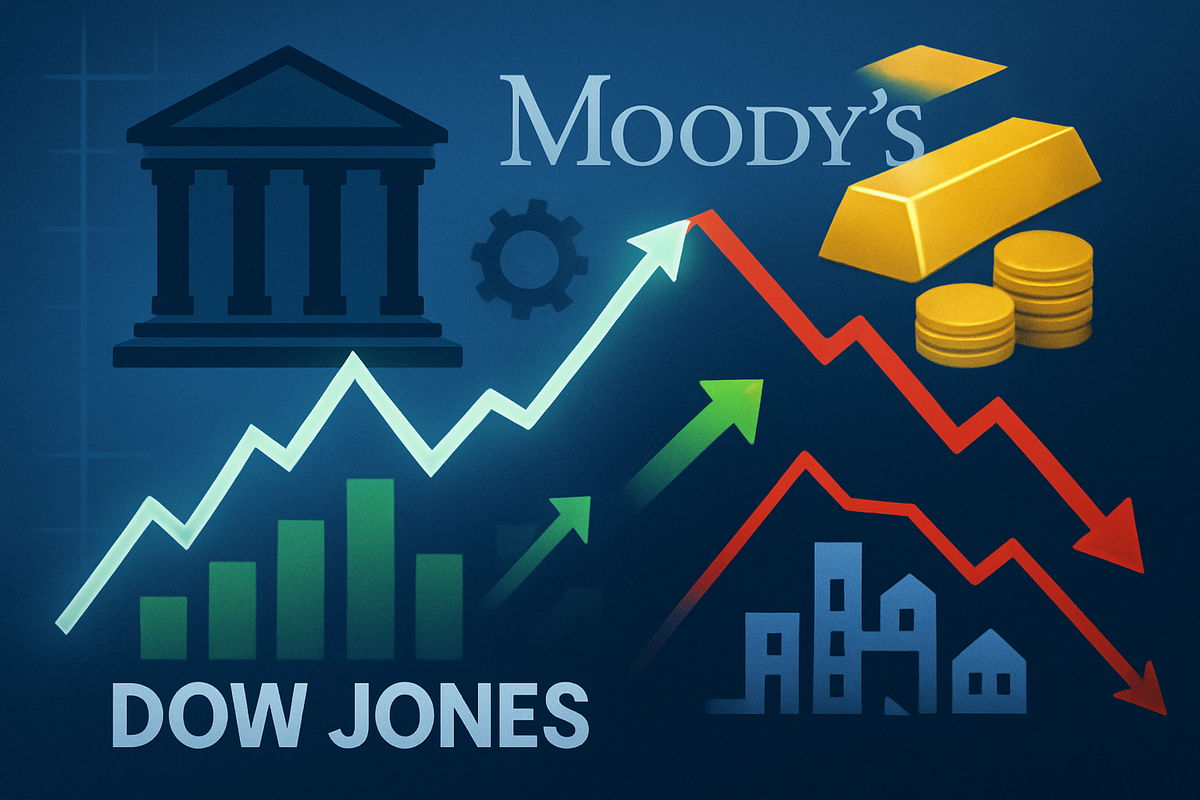
October 17, 2025 – Today, the financial markets witnessed a significant shift in sentiment, with the Dow Jones Industrial Average posting gains as Moody's provided crucial reassurances regarding the health of the U.S. banking sector. This positive development helped to calm anxieties that had been building in recent days, leading to a broader improvement in risk appetite among investors. However, this bullish turn for equities presented a contrasting picture for gold stocks, which experienced a sharp decline despite gold itself briefly hitting a fresh all-time record high. The market's day was characterized by a complex interplay of banking sector stability, geopolitical developments, and the ever-present allure of safe-haven assets.
The immediate implications of these events are a clear rotation of capital from perceived safe havens back into riskier assets, particularly equities. While the Dow's upward movement signals renewed confidence in the broader economy, the dive in gold stocks highlights the sensitivity of precious metal investments to shifts in market sentiment and the perceived need for security. This dynamic day underscores the swift and sometimes contradictory reactions of different asset classes to evolving financial narratives.
Detailed Market Movements and Key Influences
The primary catalyst for today's market uplift was a series of reassuring statements from Moody's, specifically from Marc Pinto, the head of global private credit. Pinto directly addressed and dismissed growing concerns about the credit quality within the U.S. banking system, asserting that the sector remains robust with "little evidence of deterioration in the asset quality in the banking system as a whole." These comments were a direct counter to anxieties that had intensified after a notable sell-off in regional bank shares on Thursday.
The preceding days had seen a build-up of unease, sparked by revelations from Zions Bancorp NA (NASDAQ: ZION) regarding a $50 million charge-off linked to commercial and industrial loans, and Western Alliance Bancorp (NYSE: WAL) disclosing fraud allegations against a borrower. These specific incidents, coupled with JPMorgan Chase (NYSE: JPM) CEO Jamie Dimon's earlier caution about "when you see one cockroach, there are probably more," had fueled speculation of broader systemic issues. Pinto directly challenged this narrative, stating, "One cockroach does not a trend make," and further emphasized the low default rates on high-yield debt, predicting a decline in 2026.
In response to Moody's calming pronouncements, the Dow Jones Industrial Average, which had been struggling earlier in the session, surged higher. The Dow Jones Industrial Average ETF (NYSEARCA: DIA) initially saw a decline but later in the day, the index posted a gain of 0.40%, or 184.02 points, closing at 46,136.26. This upward movement clearly demonstrated a rebound in investor confidence as fears surrounding credit quality in the banking sector subsided. U.S. equities, in general, pared earlier losses, reflecting a significant improvement in overall risk sentiment across the market.
In stark contrast to the rising equity markets, gold stocks experienced a significant downturn. This occurred even as spot gold briefly touched a new all-time high of $4,379.29 per ounce earlier in the day. Gold had been on a powerful and sustained rally, gaining over 5% this week and marking its ninth consecutive weekly gain, extending its record-breaking ascent to a fifth straight session, even approaching the $4,400 per ounce mark. This surge in gold prices was fueled by a confluence of factors, including growing expectations of a Federal Reserve interest rate cut, renewed U.S.-China tariff tensions, and a general flight to safe-haven assets amidst persistent economic and geopolitical uncertainties. However, as risk sentiment improved throughout the day, particularly after former President Donald Trump signaled a more conciliatory stance on trade negotiations with China, gold prices retreated from their record highs. Spot gold fell 2.3% to $4,226.43 per ounce, and U.S. Gold Futures for December slipped 1.5% to $4,237.69 an ounce. The subsequent decline in gold stocks, such as Barrick Gold (NYSE: GOLD) and Newmont Corporation (NYSE: NEM), directly reflects this broader move away from safe-haven assets as market fears subsided and investors sought opportunities in equities.
Company Winners and Losers in the Current Climate
The market's reaction to Moody's reassurances created a clear delineation between potential winners and losers, particularly within the financial and precious metals sectors. Banks, especially regional banks that had faced significant pressure, emerged as the primary beneficiaries. Companies like Zions Bancorp NA (NASDAQ: ZION) and Western Alliance Bancorp (NYSE: WAL), which were at the epicenter of recent credit quality concerns, likely saw some relief and a potential rebound in their stock prices as the broader fears surrounding asset quality were assuaged. Larger, diversified financial institutions such as JPMorgan Chase (NYSE: JPM), Bank of America (NYSE: BAC), and Wells Fargo (NYSE: WFC) also benefited from the improved sentiment, as a stable banking system is foundational to their operations and overall market confidence. The allaying of systemic fears reduces the likelihood of widespread loan defaults or liquidity issues, bolstering their balance sheets and lending outlooks.
Conversely, gold mining companies bore the brunt of the market's shift away from safe-haven assets. Despite gold's impressive run to record highs earlier in the day, the subsequent retreat in prices, driven by improved risk sentiment, led to a dive in the valuations of gold-focused equities. Major players in the gold mining sector, including Barrick Gold (NYSE: GOLD), Newmont Corporation (NYSE: NEM), and Kinross Gold (NYSE: KGC), saw their share prices decline. These companies' profitability is directly tied to the price of gold, and while a high gold price is generally beneficial, a sudden drop, even from a record, can trigger significant selling pressure as investors reallocate capital. For these companies, the short-term outlook becomes more volatile, as they navigate fluctuating commodity prices and investor sentiment.
The divergence highlights a fundamental principle of market dynamics: when perceived risks in the broader financial system diminish, the appeal of traditional safe havens like gold often wanes. This leads to a rotation of funds from gold and gold-related assets into equities, particularly those tied to economic growth and stability. While the long-term fundamentals for gold may remain strong due to underlying geopolitical and economic uncertainties, the immediate reaction of gold stocks underscores their sensitivity to short-term shifts in investor confidence and risk appetite.
Wider Significance and Broader Market Implications
Today's market dynamics, driven by Moody's intervention and the contrasting performances of equities and gold, fit into several broader industry trends and carry significant wider implications. Firstly, the event underscores the critical role of credit rating agencies in shaping market sentiment and maintaining financial stability. In an era where information spreads rapidly and market fears can escalate quickly, a credible voice like Moody's can effectively allay concerns and prevent broader contagion, especially in sensitive sectors like banking. This highlights the ongoing importance of transparent communication from financial authorities and institutions during periods of uncertainty.
The incident also highlights the persistent fragility within the banking sector, particularly among regional banks, which have faced increased scrutiny and pressure since early 2023. While Moody's assessment offered a reprieve, the underlying issues that led to concerns about Zions Bancorp and Western Alliance Bancorp, such as commercial real estate exposure and loan quality, remain relevant. These events serve as a reminder that despite overall stability, individual institutions can still face challenges, potentially leading to regulatory or policy implications. Regulators may intensify their oversight of loan portfolios and risk management practices, especially in the commercial and industrial loan segments, to prevent future surprises.
Historically, periods of financial uncertainty often see a flight to quality, with gold serving as a primary safe haven. The recent rally in gold to record highs, fueled by rate cut expectations and geopolitical tensions, aligns with this historical precedent. However, today's retreat in gold prices and gold stocks, coinciding with improved risk sentiment, demonstrates the cyclical nature of safe-haven demand. When perceived risks subside, investors tend to reallocate capital towards growth-oriented assets. This dynamic has ripple effects on competitors and partners across various industries, as capital flows dictate investment opportunities and cost of capital. For instance, a more stable banking sector is beneficial for businesses across the economy, as it ensures access to credit and reduces financial uncertainty.
What Comes Next: Navigating Future Market Landscapes
Looking ahead, the short-term outlook for the banking sector appears to be one of cautious optimism, largely due to Moody's reassurances. However, vigilance remains key. Investors will be closely watching upcoming earnings reports from banks for further insights into asset quality, loan growth, and overall profitability. Any renewed signs of deterioration in loan portfolios or unexpected charge-offs could quickly reignite fears. In the long term, banks may need to adapt their lending strategies, particularly in areas identified as potentially risky, and enhance their stress testing to better withstand adverse economic conditions. Strategic pivots might include diversifying revenue streams, optimizing capital allocation, and potentially consolidating within the regional banking space to achieve greater scale and resilience.
For gold and gold stocks, the immediate future may involve increased volatility as the market continues to weigh safe-haven demand against improving risk sentiment. While the factors that drove gold to record highs – such as potential Federal Reserve interest rate cuts and geopolitical uncertainties – are still present, any further easing of global tensions or stronger economic data could put downward pressure on prices. Gold companies will need to focus on cost management and operational efficiency to maintain profitability amidst fluctuating commodity prices. Market opportunities could emerge for investors willing to buy gold stocks on dips, anticipating a renewed rally if global uncertainties persist or escalate. Conversely, challenges include managing investor expectations and navigating a potentially less favorable pricing environment if the global economy stabilizes significantly.
Potential scenarios range from a sustained period of market stability, with equities continuing their upward trajectory and gold consolidating or retreating further, to a resurgence of risk aversion if new economic or geopolitical shocks emerge. In the latter case, gold could resume its rally, and gold stocks might recover. Investors should watch for key economic indicators, Federal Reserve communications on monetary policy, and developments in international trade relations. These factors will significantly influence capital flows between equities and safe havens, shaping market opportunities and challenges in the coming months.
Comprehensive Wrap-Up and Forward Outlook
Today's market movements provided a compelling narrative of financial market resilience and dynamic asset allocation. The key takeaway is the significant impact that credible reassurances from institutions like Moody's can have on investor sentiment, effectively calming fears and re-instilling confidence in critical sectors like banking. This led to a notable uplift in the Dow Jones Industrial Average, signaling a broader return to risk-on investing. Concurrently, the contrasting performance of gold stocks, which dived despite gold's earlier record-breaking ascent, underscored the immediate rotation away from safe-haven assets when perceived market risks diminish.
Moving forward, the market is likely to remain highly sensitive to incoming economic data, corporate earnings, and geopolitical developments. While the banking sector has received a temporary reprieve, investors will continue to scrutinize credit quality and regulatory pronouncements. For gold, its role as a safe haven remains intact, but its price trajectory will be heavily influenced by the pace of potential interest rate cuts and the evolution of global uncertainties. Investors should maintain a diversified portfolio, carefully assessing the risk-reward profiles of different asset classes.
The lasting impact of today's events lies in the demonstration of how swiftly market sentiment can shift and how interconnected various financial segments are. What investors should watch for in the coming months includes any further statements from credit rating agencies, the Federal Reserve's stance on monetary policy, and the trajectory of U.S.-China trade relations. These factors will be crucial in determining whether the current market optimism is sustained or if a renewed flight to safety will once again propel gold and other defensive assets.
This content is intended for informational purposes only and is not financial advice






